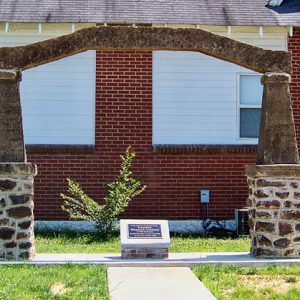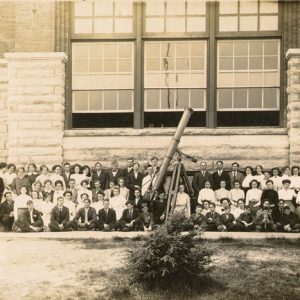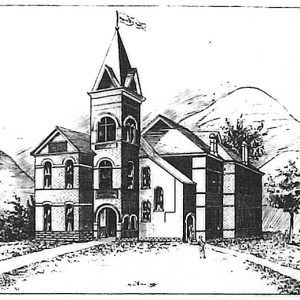calsfoundation@cals.org
Mountain Mission Schools
The term “mountain mission school” refers to a specific kind of private school or college of the late nineteenth and early twentieth centuries. Most often focusing on secondary education for white children in the highland South, mountain mission schools were one of several kinds of mission schools that developed from the efforts of northern religious denominations to found schools for the children of former slaves during and after the Civil War. At least seven different denominations established and maintained mountain mission schools in Arkansas. They varied widely in academic, religious, and cultural emphasis and were differentiated from other denominational schools either by their conscious designation as “mountain mission” schools or by their motives and rhetoric suggesting cultural assumptions and goals specific to the residents of the rural highland South.
Mountain mission schools are most often associated with Appalachia, for it was there in the 1880s that the first mountain mission schools were established. These schools emerged as an extension of post–Civil War freedmen’s schools and were also influenced by the settlement school movement then influencing social welfare efforts in American and British urban areas. Consequently, the early Appalachian mountain mission schools often operated from the same cultural assumptions and with similar educational blueprints. Recognizing the lack of educational resources in the mountains and assuming that the residents of rural Appalachia, like the former slaves, were intellectually and culturally inferior, missionary educators established schools that offered a mix of traditional academic subjects with industrial or vocational education. In addition, they often indoctrinated students in the tenets of the sponsoring religious body.
Although Benton County’s Rogers Academy, established by Congregationalists in 1883 and later adopted by the American Home Missionary Society, might technically be considered the state’s first mountain mission school, its rigid college preparatory curriculum and its prominent cultural position in one of northwestern Arkansas’s booming railroad towns renders Rogers Academy a poor representative of the genre. More illustrative of the typical mountain mission school, and thus a better candidate as Arkansas’s first such institution, was the Helen Dunlap School for Mountain Girls, established at Winslow (Washington County) in 1905. Sponsored by the Episcopal Church’s Diocese of Arkansas, the Helen Dunlap School offered a common school curriculum focusing on reading, writing, and mathematics, and maintained an active vocational training component. This latter element was exemplified by the school’s rug-weaving program, an educational and money-making enterprise modeled after older Appalachian settlement school programs that often tapped into national notions of traditional craft production in the mountains. Likewise, Mountain Crest Academy in Franklin County, founded in 1915 by the Arkansas Synod of the Presbyterian Church in the United States—known colloquially as the Southern Presbyterians—maintained its own rug-weaving program in the 1920s.
Both schools and their rug-weaving industries received financial support from the Daughters of the American Revolution (DAR), an organization that funded a variety of mountain mission schools and trumpeted the supposed Anglo-Saxon racial purity of students in the Appalachians and Ozarks. Race played an integral role in the movement. Not only were all Arkansas mountain mission schools open to white students only and generally located in areas of the state with few or no African Americans, but the rhetoric and pronouncements of the schools sometimes championed their students as a last bastion of white Protestantism amidst the unbridled immigration of non-Protestants from southern and eastern Europe during the decades preceding World War I.
Some mountain mission schools in Arkansas reflected the growing emphasis on Social Gospel–type outreach in the mission schools of Appalachia. Among these was the Kingston School in Madison County. Operated by the Reverend Elmer J. Bouher of the Presbyterian Church in the U.S.A. (Northern Presbyterians), the Kingston School combined a common school education with extensive vocational training (agriculture, blacksmithing, carpentry, printing, domestic science, etc.) with active outreach programs for local farm families. Rev. Bouher personally campaigned for improved roads, recruited experts to teach modern farming techniques, established the community’s first medical clinic, and battled moonshiners and bootleggers.
Many of Arkansas’s mountain mission schools avoided the social uplift programs of the Social Gospel and concentrated exclusively on teaching and often proselytizing. The schools of the Ozark Division of the Southern Baptist Convention (SBC) best reflect this blueprint. Under the leadership of preacher and teacher Hugh D. Morton, the Southern Baptists founded more mountain mission schools in Arkansas than did any other denomination. Beginning in 1916 with its sponsorship of Mountain Home College in Baxter County and Maynard Academy in Randolph County, the SBC’s Home Mission Board ultimately sponsored six schools, including institutions at Blue Eye (Carroll County), Hagarville (Johnson County), Parthenon (Newton County), and Mount Ida (Montgomery County). During his years as superintendent of the Ozark Division, Morton maintained statistical records detailing enrollments as well as spiritual conversions at each school.
Reflecting the ambiguity of the freedmen’s schools on which they were modeled, mountain mission schools left a mixed legacy in Arkansas by the time they faded from existence during the Great Depression. Though often motivated by stereotypes and patronizing misperceptions of life in the Ozarks and Ouachitas, mountain mission schools invariably improved educational opportunities for the rural students they reached. Mountain mission school graduates were often the first people from their communities to attend college. Furthermore, their usually high academic standards frequently led to emulation by neighboring public schools. Most mountain mission schools, in fact, ceased to exist once the communities in which they operated developed sufficient interest and funding to found public high schools.
The following is a list of known mountain mission schools as well as schools and colleges that received funds earmarked for missionary education to southern whites in Arkansas.
| SCHOOL | SPONSORING DENOMINATION | LOCATION |
| Arkansas Conference College | Methodist Episcopal (Northern Methodist) | Siloam Springs (Benton County) |
| Caddo Valley Academy | Presbyterian Church in the U.S. (Southern Presbyterian) | Norman (Montgomery County) |
| Hagarville Academy | Southern Baptist | Hagarville (Johnson County) |
| Helen Dunlap School for Mountain Girls | Episcopal | Winslow (Washington County) |
| Hill Top Mission School | United Presbyterian Church in North America | Hill Top (Boone County) |
| Kingston School | Presbyterian Church in the U.S.A. (Northern Presbyterian) | Madison County |
| Maynard Academy | Southern Baptist | Maynard (Randolph County) |
| Montview School | Southern Baptist | Blue Eye (Carroll County) |
| Mount Ida Academy | Southern Baptist | Mount Ida (Montgomery County) |
| Mountain Crest Academy | Presbyterian Church in the U.S. (Southern Presbyterian) | Franklin County |
| Mountain Home College | Southern Baptist | Mountain Home (Baxter County) |
| Newton County Academy | Southern Baptist | Parthenon (Newton County) |
| Rogers Academy | Congregational | Rogers (Benton County) |
| Sloan-Hendrix Academy | Methodist Episcopal, South | Imboden (Lawrence County) |
| Valley Springs Training School | Methodist Episcopal, South | Boone County |
| Winchester School for Mountain Boys | Episcopal | Havana (Yell County) |
For additional information:
Alvic, Philis. “Settlement, Mission, and Sponsored Schools.” In Encyclopedia of Appalachia, edited by Rudy Abramson and Jean Haskell. Knoxville: University of Tennessee Press, 2006.
Blevins, Brooks. “Mountain Mission Schools in Arkansas.” Arkansas Historical Quarterly 70 (Winter 2011): 398–428.
———. “Region, Religion, and Competing Visions of Mountain Mission Education in the Ozarks.” Journal of Southern History 82 (February 2016): 59–96.
Burnett, Abby. When the Presbyterians Came to Kingston: Kingston Community Church, 1917–1951. Kingston, AR: Bradshaw Mountain Publishers, 2000.
Shapiro, Henry D. Appalachia on Our Mind: The Southern Mountains and Mountaineers in the American Consciousness, 1870–1920. Chapel Hill: University of North Carolina Press, 1978.
Brooks Blevins
Missouri State University
 Abbott Institute Arch
Abbott Institute Arch  Arkansas Conference College
Arkansas Conference College  Mountain Home Baptist College
Mountain Home Baptist College 



Comments
No comments on this entry yet.